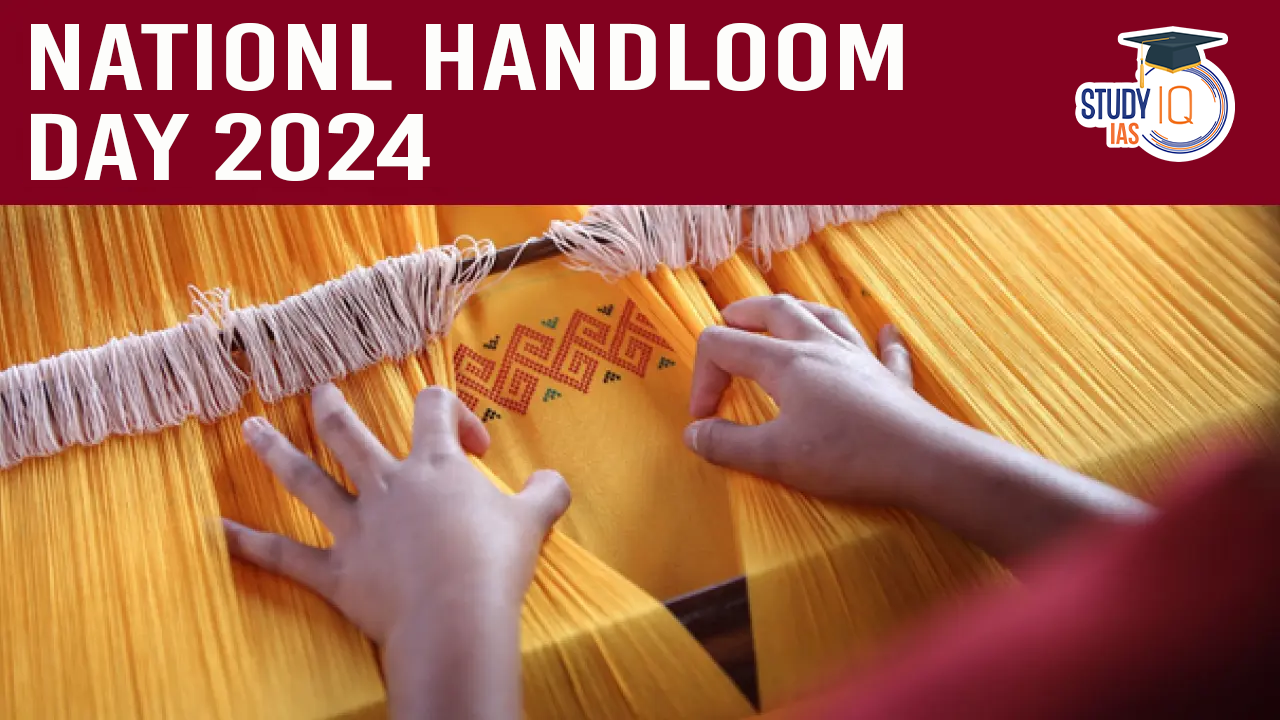Table of Contents
National Handloom Day is a momentous occasion celebrated on August 7th each year in India, recognizing and honoring the nation’s rich handloom heritage. This day plays a crucial role in promoting indigenous craftsmanship, supporting weavers, and highlighting the socio-economic significance of the handloom sector. As National Handloom Day 2024 unfolds, let’s see its theme, historical roots, and the profound significance it holds for India.
What is National Handloom Day?
National Handloom Day is dedicated to celebrating India’s illustrious handloom industry, which has been an integral part of the country’s cultural and economic fabric for centuries. Established in 2015, the day honors the traditional art of handloom weaving and aims to foster appreciation for this age-old craft while addressing contemporary challenges faced by the handloom sector.
| National Handloom Day 2024: Overview | |
|---|---|
| Date | August 7, 2024 |
| Inception | 2015, commemorating the Swadeshi Movement of 1905 |
| Purpose | To celebrate and promote handloom products, support weavers, and honor India’s traditional textile heritage |
| Theme 2024 | Integration of technology and innovation in handloom weaving; fostering skill development and expanding market access |
National Handloom Day Theme 2024
The theme for National Handloom Day 2024 centers on the integration of technology and innovation within the handloom sector. This theme aims to:
- Enhance Skill Development: Provide training and resources to upgrade the skills of weavers.
- Expand Market Access: Facilitate broader market reach for handloom products through various channels.
- Promote Innovation: Encourage the adoption of modern technology to improve productivity and quality in handloom weaving.
This focus on technology and innovation reflects the evolving needs of the industry, aiming to bridge the gap between traditional practices and contemporary demands.
Historical Background of National Handloom Day
National Handloom Day has its roots in the Swadeshi Movement of 1905, a pivotal event in India’s struggle for independence. The movement, which began on August 7th in Kolkata, sought to promote indigenous products and reduce reliance on British goods. Handloom textiles played a crucial role in this movement, symbolizing self-reliance and national pride.
In 2015, the Indian government designated August 7th as National Handloom Day to commemorate the centenary of the Swadeshi Movement. This initiative highlights the importance of handloom weaving as a symbol of resistance and self-sufficiency during the colonial era.
Significance of National Handloom Day
National Handloom Day 2024 holds profound significance for various reasons:
- Economic Contribution:
The handloom sector is a major employment provider, second only to agriculture in India. According to the Handloom Census 2019-20, approximately 35.22 lakh workers are employed in the handloom industry, with a significant proportion being women. The sector also plays a crucial role in rural development and contributes to India’s GDP and export earnings. In the fiscal year 2023-24, handloom products contributed $1802.36 million to export earnings. - Cultural Heritage:
India’s handloom industry is known for its diverse range of textiles, each reflecting unique regional identities and traditional craftsmanship. Handloom products, such as Banarasi saris, Pashmina shawls, and Ikkat fabrics, are celebrated for their intricate designs and cultural significance. These textiles preserve centuries-old techniques and patterns, enriching India’s cultural tapestry. - Social Impact:
Handloom weaving provides economic empowerment, particularly to women, and supports sustainable fashion practices. By avoiding mechanized production, handloom weaving aligns with global trends towards eco-friendly and sustainable fashion, contributing to climate change mitigation.
Government Initiatives and Policies
To support and promote the handloom sector, the Indian government has implemented several schemes:
- National Handloom Development Programme (NHDP): Provides financial assistance for technology upgrades, marketing support, and skill development.
- Handloom Weavers’ Comprehensive Welfare Scheme: Offers health and life insurance coverage to handloom weavers.
- Yarn Supply Scheme: Ensures the regular supply of yarn at subsidized rates to enhance production.
- MUDRA Scheme for Weavers: Provides loans up to INR 10 lakhs to support business development and growth in the handloom sector.
- Marketing Support: Includes organizing national and international exhibitions and collaborating with e-commerce platforms to broaden market reach.
Challenges Faced by Handloom Sector
Despite its importance, the handloom sector faces several challenges:
- Competition from Power Looms: Mechanized production impacts demand for handloom products, leading to lower prices and reduced demand.
- Lack of Modernization: Many weavers use traditional methods without access to modern technology, affecting productivity and quality.
- Market Access Issues: Limited market reach and exploitation by middlemen hinder profitability and growth.
- Financial Constraints: Difficulty in accessing credit and high input costs impact the sustainability of handloom businesses.
National Handloom Day UPSC
Understanding National Handloom Day 2024 and the handloom sector is valuable for UPSC aspirants for several reasons:
- Economic Relevance: Knowledge of the sector’s contribution to GDP and export potential is crucial for economic-related questions.
- Social Impact: Insights into the sector’s role in rural development and women empowerment are relevant for social issue discussions.
- Government Policies: Familiarity with government schemes and policies supports questions on governance and public administration.
- Environmental Aspects: Handloom’s sustainability aligns with discussions on environmental and climate change topics.
Conclusion
National Handloom Day 2024 is a celebration of India’s rich handloom heritage, emphasizing the integration of technology and innovation in traditional weaving practices. By acknowledging the sector’s economic, cultural, and social contributions, this day highlights the need for modernization, empowerment, and sustainable growth. Understanding the significance of National Handloom Day provides valuable insights into India’s diverse economy and cultural heritage, making it an essential topic for both general knowledge and UPSC preparation.


 Asia’s Largest Tulip Garden
Asia’s Largest Tulip Garden
 World Happiness Report 2025, India's Ran...
World Happiness Report 2025, India's Ran...
 World Water Day 2025, Date, Theme, Histo...
World Water Day 2025, Date, Theme, Histo...





















